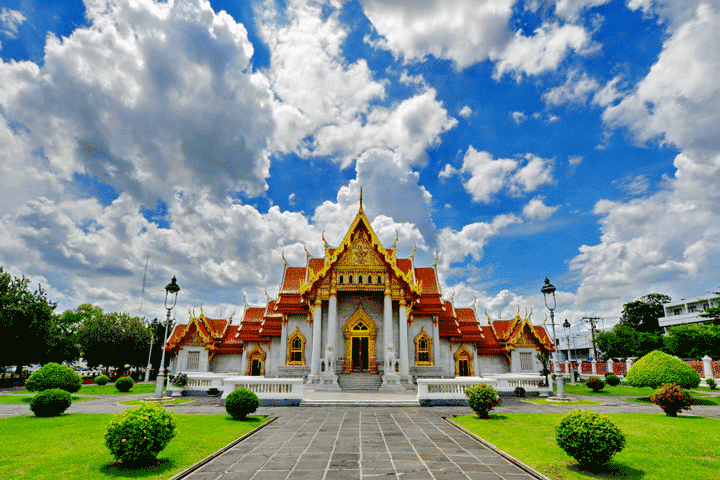Wat Benchamabophit, the marble temple in Bangkok
It is one of the most famous temples in Thailand and therefore definitely worth a visit. The Wat Benchamabophit Dusitwanaran in Bangkok is often referred to as 'Wat Ben' by the locals, foreign visitors mainly know it as the 'Marble Temple'. Even if you have never been there, you may have seen it, because the temple is on the back of a 5 Baht coin.
Construction of Wat Benchamabophit Dusitwanaran started in 1899, during the reign of King Chulalongkorn (King Rama V). As with the nearby Dusit Palace and the Ananta Samakhom Throne Hall, the design shows European influences. Italian white marble was used on a large scale for the construction of the Wat Benchamabophit.
After the death and cremation of King Rama V, his ashes were placed in the plinth of the main Buddha statue found in the ordination hall. Classed as a royal temple of the highest rank, Wat Benchamabophit is associated with King Rama V and also with Rama IX (King Bhumibol Adulyadej) who resided here as a young man when he was ordained as a monk.
Wat Benchamabophit may not be as grand as Wat Pho or Wat Phra Kaeo, but it is an extraordinary cluster of buildings with beautiful design details, including impressive stained glass windows. Another advantage is that Wat Ben attracts less tourists than the aforementioned temples, so it is not as crowded.
Especially if you are in the Dusit area, you should check it out and pay particular attention to the beautiful details that illustrate the Siamese craftsmanship, you won't regret it. The temple is open to visitors from 08.00 a.m. to 18.00 p.m. The entrance fee to the main temple is 20 Baht and 50 Baht for non-Thai.
Which almost no one knows
Wat Benchamabophit, also known as the Marble Temple, is one of the most famous and visited temples in Bangkok, Thailand. However, there is a lesser-known story behind the serene walls of this sacred site, something that many visitors and even some locals don't know.
Within the tranquil confines of Wat Benchamabophit lies a small, barely noticed library, hidden deep behind the main buildings. Called “The Archive of Forgotten Writings” (a fictional name for the context of this story), this library is home to a collection of rare manuscripts, ancient texts and artifacts that tell the story of Thailand's rich spiritual history. The collection includes texts on meditation practices found nowhere else, long-lost teachings of Thai monks, and unique Buddhist scriptures dating back to the early days of the Kingdom of Siam.
A special piece within this collection is a small, unobtrusive booklet said to contain the personal notes of one of the most revered monks to ever live in the temple. This booklet, often called “The Whispering Path,” details a path to inner peace and enlightenment that has not yet been explored by the modern world. It is said that reading and understanding these notes can lead a person to a level of meditation and awareness far beyond the reach of contemporary practices.
Access to “The Archive of Forgotten Scriptures” is strictly regulated by the temple authorities and is only open to researchers and serious students of Buddhism upon special request and under certain conditions. The reason for this limited access is not only the fragility of the documents but also the powerful knowledge they contain, which should be treated with wisdom and respect.
The Marble Temple is located in the Dusit area of Bangkok on the corner of Si Ayutthaya Road and Phra Rama V. There are no BTS Skytrain or MRT subway stations in the immediate vicinity (Phaya Thai BTS station is a 30-minute walk away) , but taxi drivers will take you there if you say 'Wat Ben' to them.

(george photo cm / Shutterstock.com)

(george photo cm / Shutterstock.com)





Wat Benchamabophit is a beautiful temple, but I think King Bhumibol stayed in Wat Bowonnivet after his initiation.
Recently visited, the outside is still very beautiful, but the temple itself urgently needs some restoration, otherwise it will deteriorate.